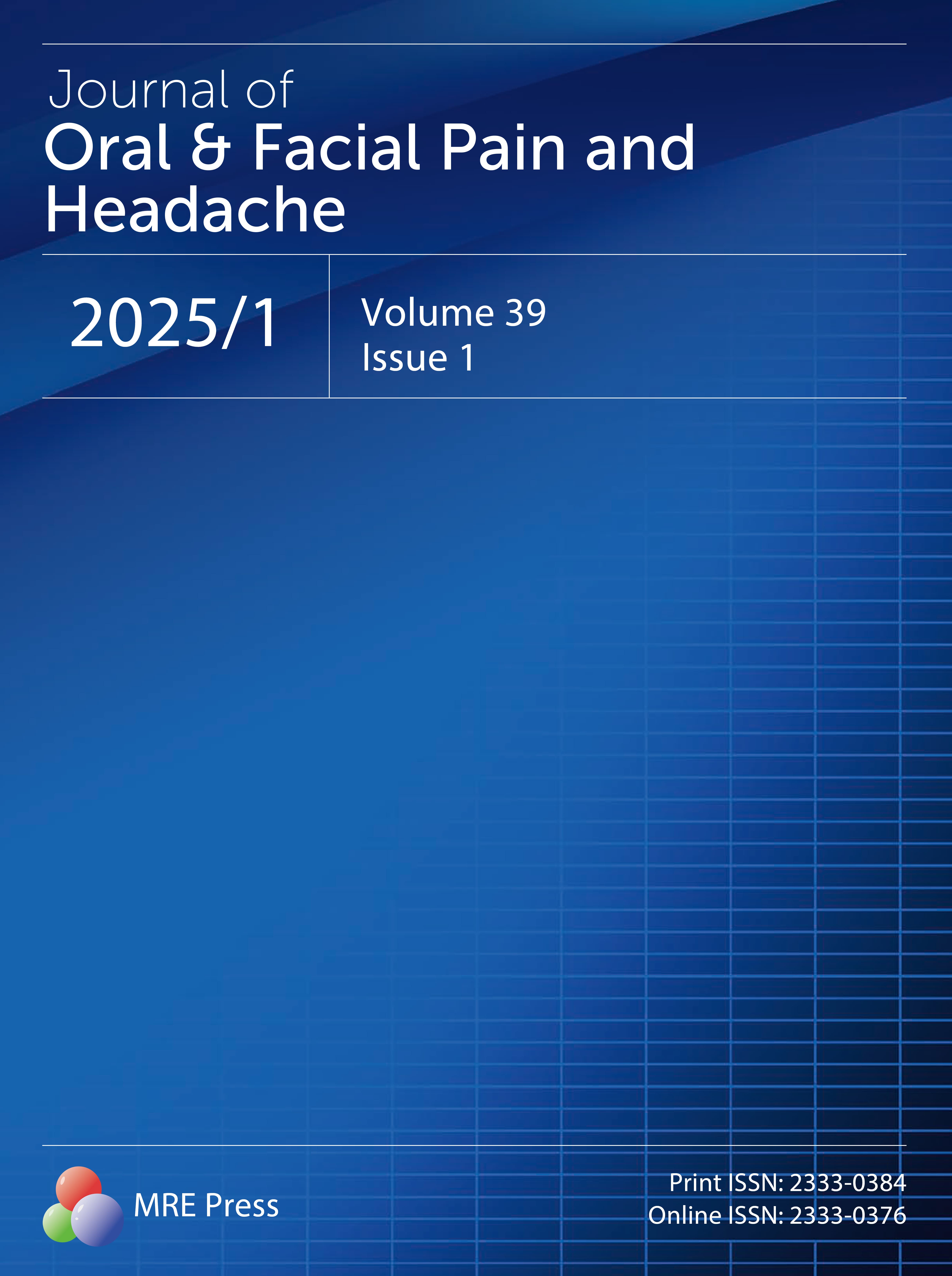Title
Author
DOI
Article Type
Special Issue
Volume
Issue
Article Menu
Export Article
More by Authors Links
Article Data
- Views 795
- Dowloads 23
Journal of Oral & Facial Pain and Headache (OFPH) is published by MRE Press from Volume 38 lssue 1 (2024). Previous articles were published by another publisher on a subscription basis, and they are hosted by MRE Press on www.jofph.com as a courtesy and upon agreement with Journal of Oral & Facial Pain and Headache.
Original Research
Open AccessBruxism Levels and Daily Behaviors: 3 Weeks of Measurement and Correlation
Bruxism Levels and Daily Behaviors: 3 Weeks of Measurement and Correlation
1Showa University, Faculty of Dentistry, Department of Geriatric Dentistry, Tokyo, Japan
2Toyoharu Dental Office, Saitama, Japan
3Oral Biology and Medicine, University of California Los Angeles, Los Angeles, California
*Corresponding Author(s): Glenn T. Clark E-mail: glennc@dent.ucla.edu
Abstract
Aims: To test whether 3-week duration recordings of sleep brux-ism are correlated with daily behaviors. Methods: Twelve patients with a sleep bruxism disorder were monitored to see if any daily behaviors (stress, physical activity, anger), jaw-pain/headache symptoms, or sleep quality were correlated with their sleep brux-ism levels. A telemetric-based system was used for monitoring bruxism levels, which were detected with an intra-appliance piezo-electric film system. Bruxism was defined as a force applied to the occlusal surface of the splint at or above a level of 10% maximum voluntary contraction. Bruxism levels were recorded at night for at least 3 weeks on the 12 subjects in this study (6 females and 6 males). Patients used standard (100 mm) visual analog scaling methods during this period to rate their daily behaviors, sleep quality, and jaw-pain/ headache symptoms in a diary. Correlation analysis was performed between these recorded variables. Results: The subjects demonstrated both bruxism and sleep disturbance, and the mean bruxism score for the male subjects was significantly higher than that for the female subjects. Overall, no single diary variable was consistently correlated with the bruxism levels in these subjects. Conclusion: These data support the conclusion that bruxism is not strongly related to any of the subject’s self-moni-tored daytime activities or sleep quality.
Keywords
bruxism; sleep quality; piezofilm
Cite and Share
Tatsutomi Watanabe, Kenich Ichikawa, Glenn T. Clark. Bruxism Levels and Daily Behaviors: 3 Weeks of Measurement and Correlation. Journal of Oral & Facial Pain and Headache. 2003. 17(1);65-73.
References
1. De Meyer MD, De Boever JA. [The role of bruxism in the appearance of temporomandibular joint disorders]. Revue Belge Med Dent 1997;52:124–138.
2. Glaros AG, Rao SM. Bruxism: A critical review. Psychol Bull 1977;84:767–781.
3. Yugami K, Yamashita S, Ai M, Takahashi J. Mandibular positions and jaw-closing muscle activity during sleep. J Oral Rehabil 2000;27:697–702.
4. Faulkner KD. Further studies of some masticatory characteristics of bruxism. J Oral Rehabil 1990;17:359–364.
5. Rugh JD, Orbach R. Occlusal parafunction. In: Mohl ND (ed). A Textbook of Occlusion. Chicago: Quintessence, 1988:249–261.
6. Satoh T, Harada Y. Electrophysiological study on tooth-grinding during sleep. Electroencephalogr Clin Neurophysiol 1973;35:267–275.
7. Molina OF, dos Santos J Jr, Nelson SJ, Grossman E. Prevalence of modalities of headaches and bruxism among patients with craniomandibular disorder. Cranio 1997;15:314–325.
8. Vanderas AP. Synergistic effect of malocclusion and oral parafunctions on craniomandibular dysfunction in children with and without unpleasant life events. J Oral Rehabil 1996;23:61–65.
9. Vanderas AP, Menenakou M, Kouimtzis T, Papagiannoulis L. Urinary catecholamine levels and bruxism in children. J Oral Rehabil 1999;26:103–110.
10. Clark GT, Rugh JD, Handelman SL. Nocturnal masseter muscle activity and urinary catecholamine levels in bruxers. J Dent Res 1980;59:1571–1576.
11. Pierce CJ, Chrisman K, Bennett ME, Close JM. Stress, anticipatory stress, and psychologic measures related to sleep bruxism. J Orofac Pain 1995;9:51–56.
12. Da Silva AM, Oakley DA, Hemmings KW, Newman HN, Watkins S. Psychosocial factors and tooth wear with a significant component of attrition. Eur J Prosthodont Restor Dent 1997;5:51–55.
13. Takeuchi H, Ikeda T, Clark GT. A piezoelectric film-based intrasplint detection method for bruxism. J Prosthet Dent 2001;86:195–202.
14. Baba K, Clark T, Watanabe T, Takashi O. Bruxism force-detection using a piezoelectric film-based recording device in sleeping humans. J Orofac Pain (in press).
15. Rugh JD, Harlan J. Nocturnal bruxism and temporo-mandibular disorders. Adv Neurol 1988;49:329–341.
16. Ekfeldt A, Hugoson A, Bergendal T, Helkimo M. An indi-vidual tooth wear index and an analysis of factors corre-lated to incisal and occlusal wear in an adult Swedish pop-ulation. Acta Odontol Scand 1990;48:343–349.
17. Solberg WK, Clark GT, Rugh, JD. Nocturnal electromyo-graphic evaluation of bruxism patients undergoing short term splint therapy. J Oral Rehabil 1975;2:215–233.
18. Clark GT, Beemsterboer PL, Solberg WK, Rugh JD. Nocturnal electromyographic evaluations of myofascial pain dysfunction patients undergoing occlusal splint therapy. J Am Dent Assoc 1979;99:607–611.

Abstracted / indexed in
Science Citation Index (SCI)
Science Citation Index Expanded (SCIE)
BIOSIS Previews
Scopus
Cumulative Index to Nursing and Allied Health Literature (CINAHL)
Submission Turnaround Time
Editorial review: 1 - 7 days
Peer review: 1 - 3 months
Publish Ahead of Print: within 2 months after being accepted
Notes: Your information is kept confidential throughout the review process.
Top
